More than 46 million homes in the U.S. have a cat, and their popularity as pets is undeniable. However, for those who are Allergic To Cats, the dream of feline companionship can often turn into a sneezing, itchy-eyed reality. If you adore cats but find yourself battling allergies, you might be wondering if there’s a way to coexist peacefully with these beloved animals. The good news is, it’s possible! While truly “hypoallergenic” cats are a myth, certain breeds produce fewer allergens, and there are effective strategies to manage your allergies and enjoy life with a feline friend.
Understanding Cat Allergies: It’s Not the Fur
Before diving into breeds and solutions, it’s crucial to understand what actually causes cat allergies. Contrary to popular belief, it’s not cat hair itself that triggers allergic reactions. The culprit is a protein called Fel d 1, primarily found in cat saliva, skin glands, and to a lesser extent, urine.
When cats groom themselves, they deposit saliva onto their fur and skin. As the saliva dries, it becomes airborne, carrying the Fel d 1 protein with it. These tiny, allergen-laden particles can then be inhaled or come into contact with your skin, triggering allergic reactions in sensitive individuals. Because cats groom frequently, allergens can easily spread throughout your home, sticking to furniture, carpets, and clothing.
Are There Truly Hypoallergenic Cats?
Let’s address the elephant in the room: no cat breed is 100% hypoallergenic. Every cat produces Fel d 1, regardless of breed, hair length, or shedding level. However, the term “hypoallergenic cat” is used to describe breeds that produce lower levels of Fel d 1 or have coat types that may trap dander and saliva more effectively, potentially reducing the spread of allergens.
For allergy sufferers, choosing a cat breed known to be “hypoallergenic” can significantly reduce allergy symptoms. It’s essential to remember that individual reactions can vary, and spending time with a specific cat breed before bringing one home is always recommended.
12 Cat Breeds Considered More Suitable for Allergy Sufferers
Here are 12 cat breeds often cited as being “hypoallergenic” or better tolerated by people with allergies. Remember to spend time with these breeds to see how your allergies react before making a commitment.
1. Siberian
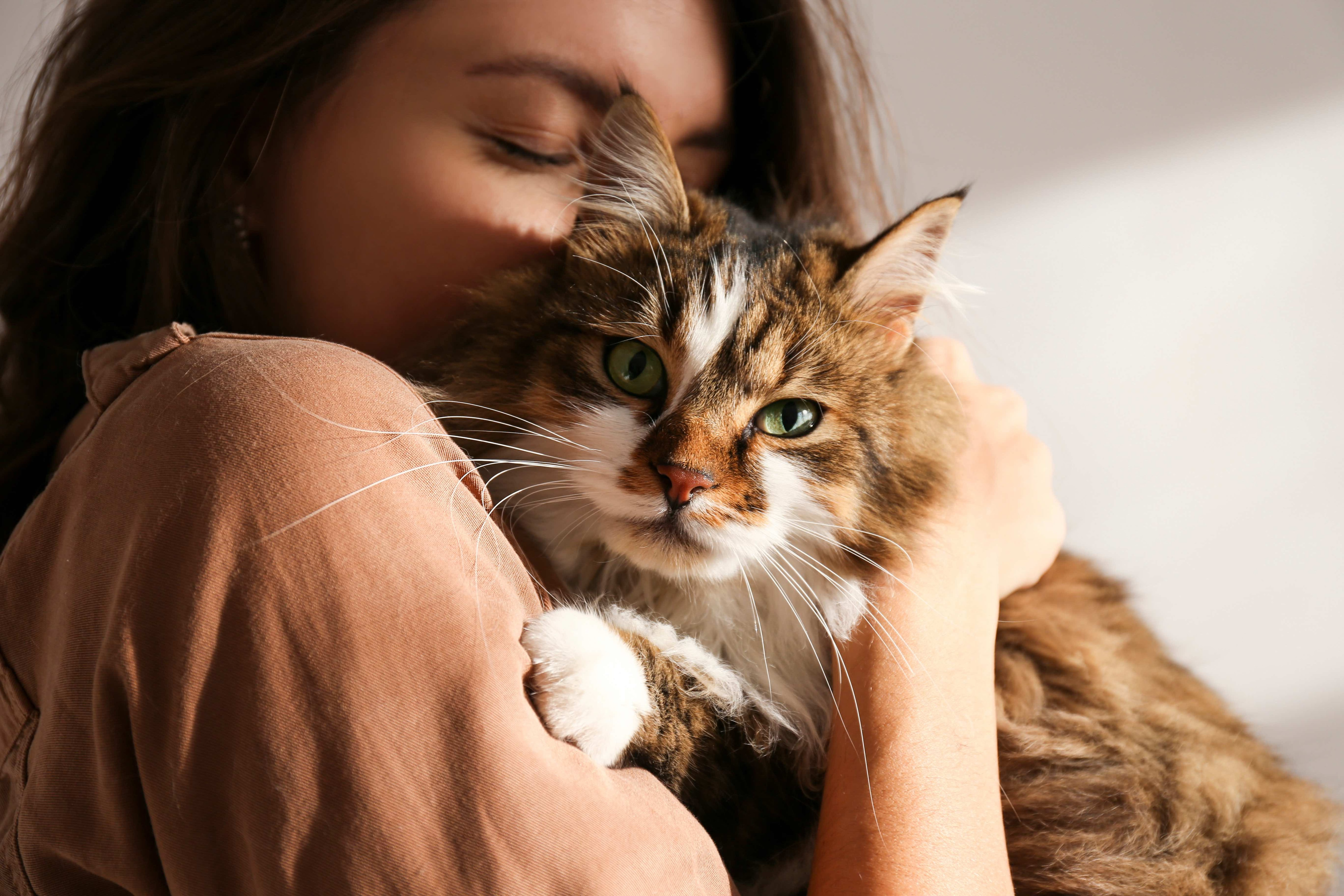 Woman affectionately cuddling a brown and white long-haired Siberian cat, highlighting the breed's suitability for people with allergies.
Woman affectionately cuddling a brown and white long-haired Siberian cat, highlighting the breed's suitability for people with allergies.
Photo credit: Adobe Stock/Evrymmnt
Siberians are surprisingly popular among allergy sufferers despite their long, luxurious coats. They are believed to produce less Fel d 1 protein compared to many other breeds. Beyond their allergy-friendliness, Siberians are known for their affectionate, friendly, and playful nature, making them excellent family pets. However, their thick coat requires regular grooming to prevent matting and tangles.
2. Siamese
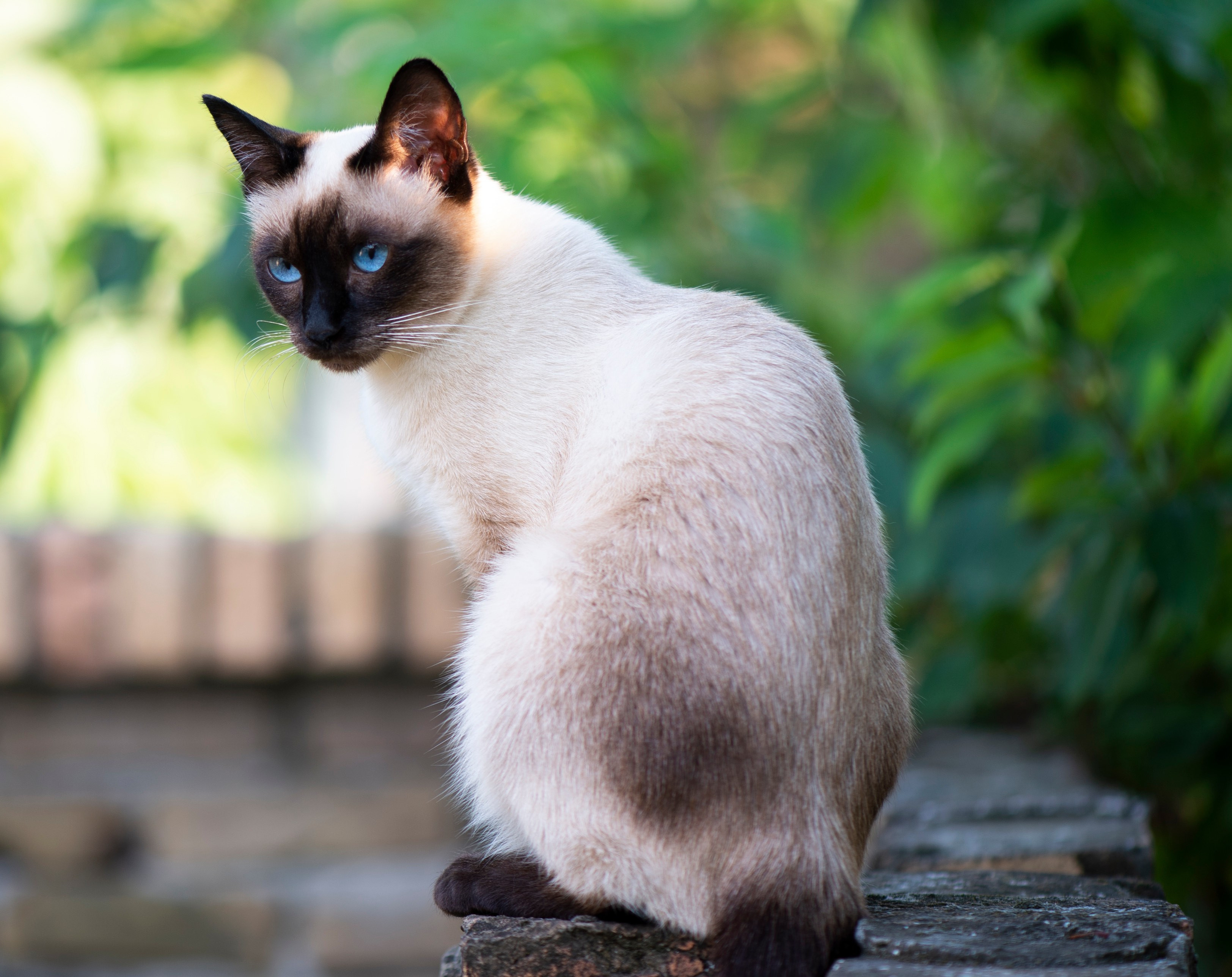 A sleek Siamese cat with piercing blue eyes sitting outdoors, showcasing its short coat which contributes to being a hypoallergenic breed.
A sleek Siamese cat with piercing blue eyes sitting outdoors, showcasing its short coat which contributes to being a hypoallergenic breed.
Photo credit: Adobe Stock/Vesna
Siamese cats, with their striking blue almond-shaped eyes and short, sleek coats, are another breed often recommended for allergy-prone individuals. While no cat is truly non-shedding, Siamese cats have a fine coat that sheds less than many other breeds, resulting in less dander and fewer allergens dispersed into the environment. Siamese cats are also known for their vocal and social personalities, forming strong bonds with their families, although they can be demanding of attention.
3. Bengal
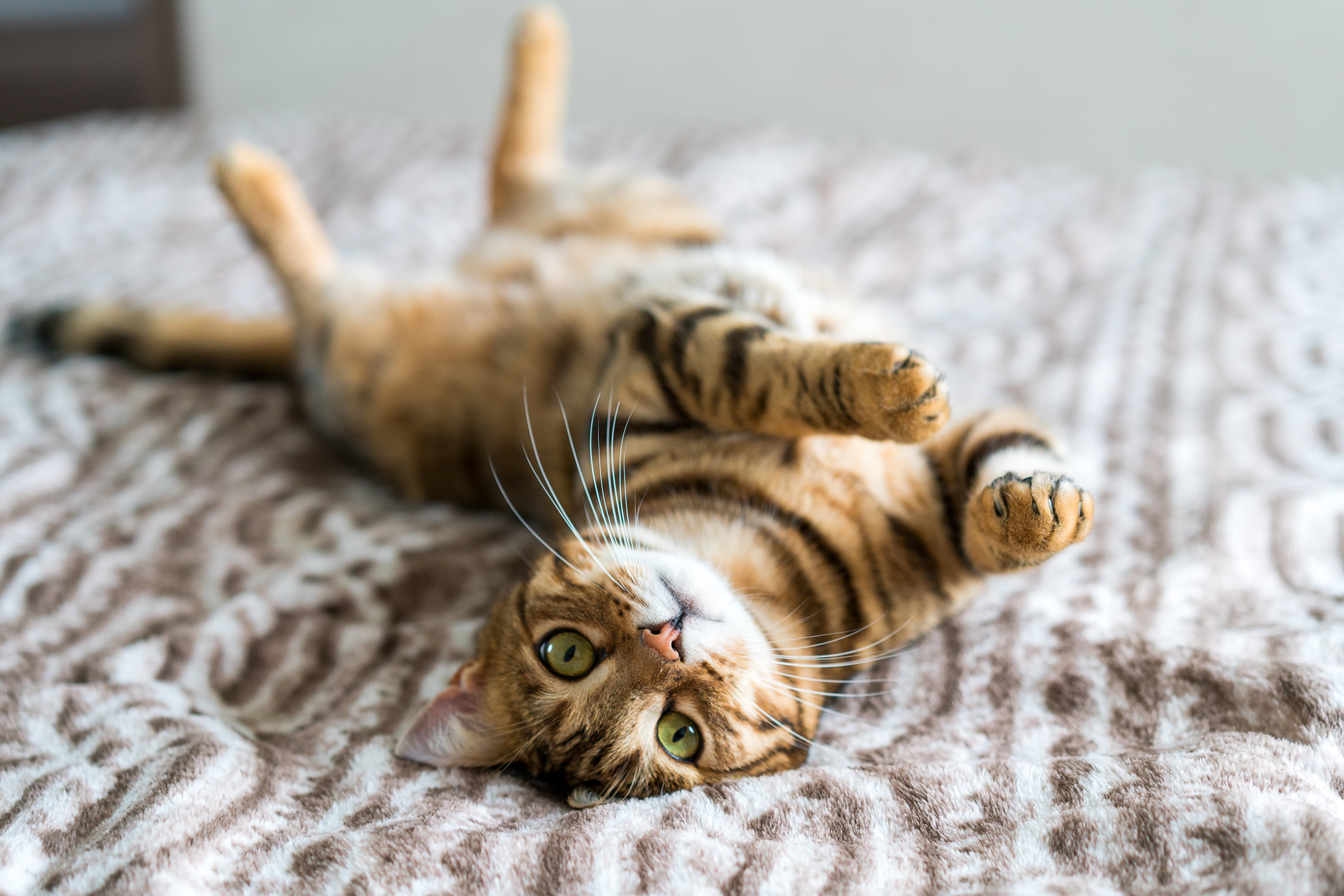 A Bengal cat lying on its back on a bed, showing its spotted belly, emphasizing the breed's unique coat and hypoallergenic qualities.
A Bengal cat lying on its back on a bed, showing its spotted belly, emphasizing the breed's unique coat and hypoallergenic qualities.
Photo credit: Adobe Stock/ingusk
Bengals are striking cats with a wild appearance thanks to their ancestry linked to the Asian Leopard Cat. Their short, dense, and uniquely spotted coats are not only beautiful but also contribute to their hypoallergenic reputation. Bengals shed minimally, reducing the spread of allergy-triggering dander. Known for their intelligence and energy, Bengals are active cats that require plenty of interaction and playtime. It’s worth noting that some regions have regulations regarding Bengal ownership due to their wild heritage.
4. Russian Blue
 A Russian Blue cat gently headbutting a man's forehead, illustrating the breed's affectionate nature and suitability for allergy sufferers.
A Russian Blue cat gently headbutting a man's forehead, illustrating the breed's affectionate nature and suitability for allergy sufferers.
Photo credit: iStock/Drazen_Hypoallergenic
Russian Blue cats are admired for their plush, silvery-blue coats, emerald green eyes, and gentle personalities. Their dense, short coat traps dander close to their skin, which may limit the release of allergens into the air. They are also known for producing less Fel d 1. Russian Blues are typically quiet, affectionate, and can be initially reserved with strangers, but they form deep bonds with their families. Regular, albeit minimal, grooming is beneficial to keep their coat healthy and reduce loose hair.
5. Sphynx
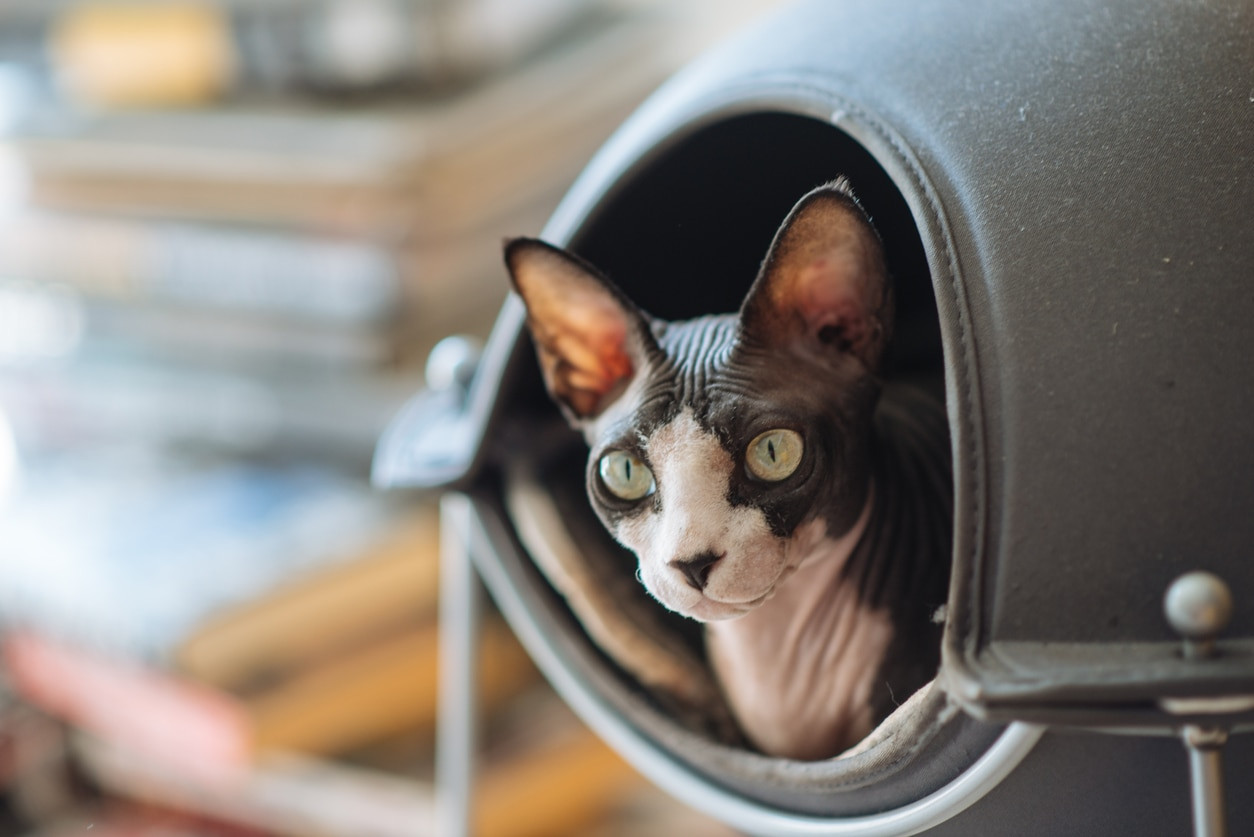 A black and pink Sphynx cat peering out from a covered cat bed, highlighting its hairless nature as a key hypoallergenic characteristic.
A black and pink Sphynx cat peering out from a covered cat bed, highlighting its hairless nature as a key hypoallergenic characteristic.
Photo credit: iStock/Drazen_
Sphynx cats are perhaps the most recognized “hypoallergenic” breed due to their almost hairless bodies. While they might have a fine layer of downy fuzz, their lack of fur means there’s no long coat to trap and shed dander. However, Sphynx cats still produce allergens in their saliva and skin secretions. Their skin produces oils that need to be regularly cleaned with baths to prevent buildup and skin issues. Sphynx cats are known for their very social, attention-seeking, and playful personalities, often described as dog-like in their devotion.
6. Devon Rex
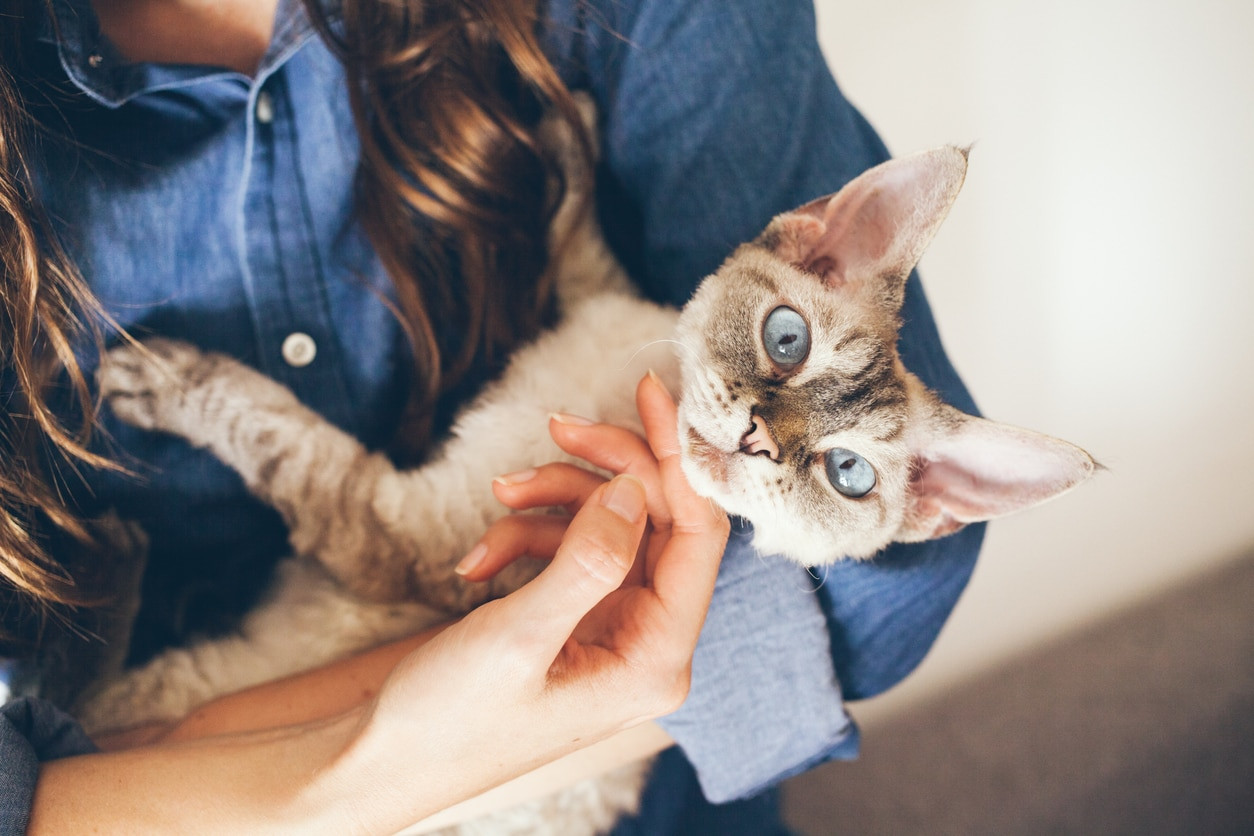 A woman cradling a Devon Rex cat like a baby, showcasing the breed's affectionate temperament and curly coat, suitable for allergy-sensitive owners.
A woman cradling a Devon Rex cat like a baby, showcasing the breed's affectionate temperament and curly coat, suitable for allergy-sensitive owners.
Photo credit: iStock/insonnia
Devon Rex cats are characterized by their large ears, elfin faces, and soft, wavy, short coats. Their unique coat texture is different from typical cat fur and sheds very little, contributing to their reputation as a good breed for allergy sufferers. Devon Rexes are intelligent, playful, and highly people-oriented, thriving on attention and interaction. They can be quite active and mischievous, needing plenty of mental and physical stimulation.
7. Cornish Rex
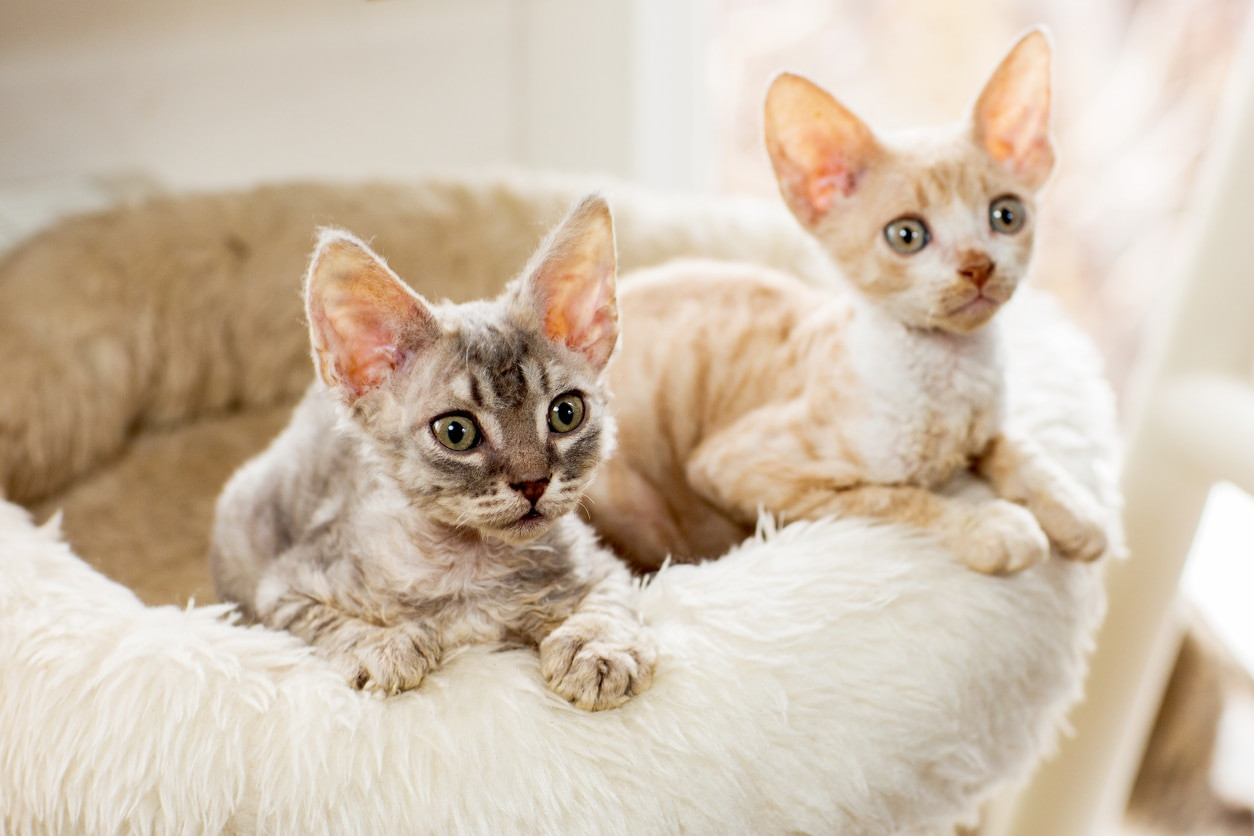 Two Cornish Rex kittens nestled together in a cat bed, emphasizing the breed's playful nature and fine, curly coat, which is low-shedding.
Two Cornish Rex kittens nestled together in a cat bed, emphasizing the breed's playful nature and fine, curly coat, which is low-shedding.
Photo credit: iStock/Sicha69
Similar to Devon Rexes, Cornish Rex cats have a distinctive curly, soft coat that lies close to their body. This fine, wavy fur sheds minimally, making them another popular choice for those with allergies. Cornish Rexes are known for being active, playful, and very affectionate, often described as kitten-like throughout their lives. They are intelligent and enjoy learning tricks and playing games, requiring regular interaction and exercise.
8. Javanese
 A grey Javanese cat mother grooming her kittens, demonstrating the breed's long coat that surprisingly still qualifies it as hypoallergenic due to lower allergen production.
A grey Javanese cat mother grooming her kittens, demonstrating the breed's long coat that surprisingly still qualifies it as hypoallergenic due to lower allergen production.
Photo credit: Adobe Stock/Heidi Bollich
Javanese cats, despite having a longer single coat, are considered hypoallergenic. Their coat is silky and fine and lacks an undercoat, resulting in less shedding. Like Siamese and Balinese cats (to which they are related), Javanese cats are thought to produce lower levels of Fel d 1. They are intelligent, vocal, and very people-oriented, enjoying being involved in household activities and demanding attention from their owners. Regular grooming is needed to maintain their coat and minimize shedding.
9. Balinese
 A long-haired Balinese cat snuggling with a woman, highlighting the breed's affectionate nature and its surprising hypoallergenic qualities despite its long coat.
A long-haired Balinese cat snuggling with a woman, highlighting the breed's affectionate nature and its surprising hypoallergenic qualities despite its long coat.
Photo credit: Adobe Stock/New Africa
Balinese cats are essentially long-haired Siamese and share many of the Siamese traits, including their lower Fel d 1 production. Despite their elegant, flowing coats, Balinese cats shed less than many long-haired breeds. They are intelligent, social, vocal, and highly affectionate, forming strong bonds with their families. Balinese cats are also known for their trainability and enjoy learning tricks, making them engaging companions.
10. Oriental Shorthair
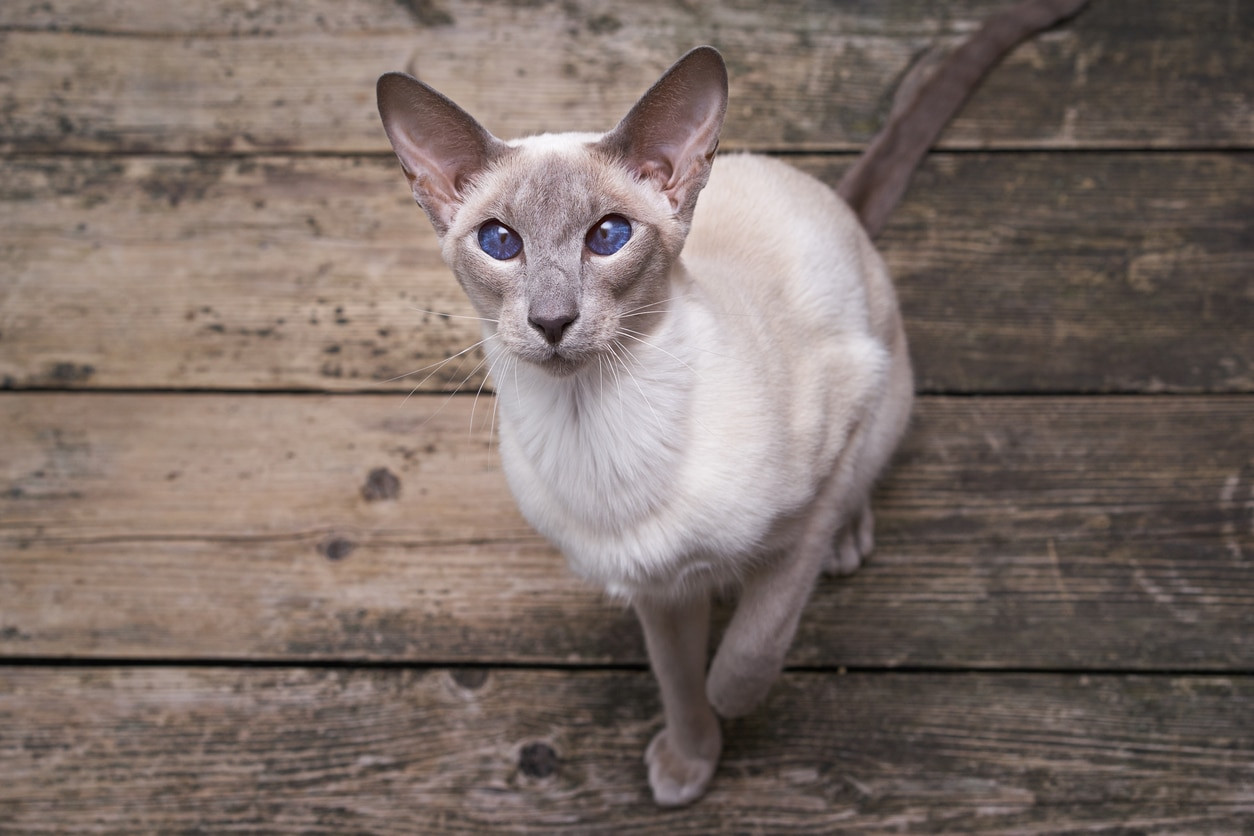 A grey and white Oriental Shorthair cat looking up at the camera, showcasing its sleek, short coat and elegant appearance, ideal for allergy sufferers.
A grey and white Oriental Shorthair cat looking up at the camera, showcasing its sleek, short coat and elegant appearance, ideal for allergy sufferers.
Photo credit: iStock/Leschenko
Oriental Shorthairs are known for their striking appearance, coming in a vast array of colors and patterns, and their sleek, short coats. Their short coat requires minimal grooming and sheds less than longer coats, contributing to their hypoallergenic nature. Oriental Shorthairs are intelligent, playful, curious, and very social cats. They thrive on interaction, are often described as “talkative,” and form strong bonds with their families, making them devoted companions.
11. Burmese
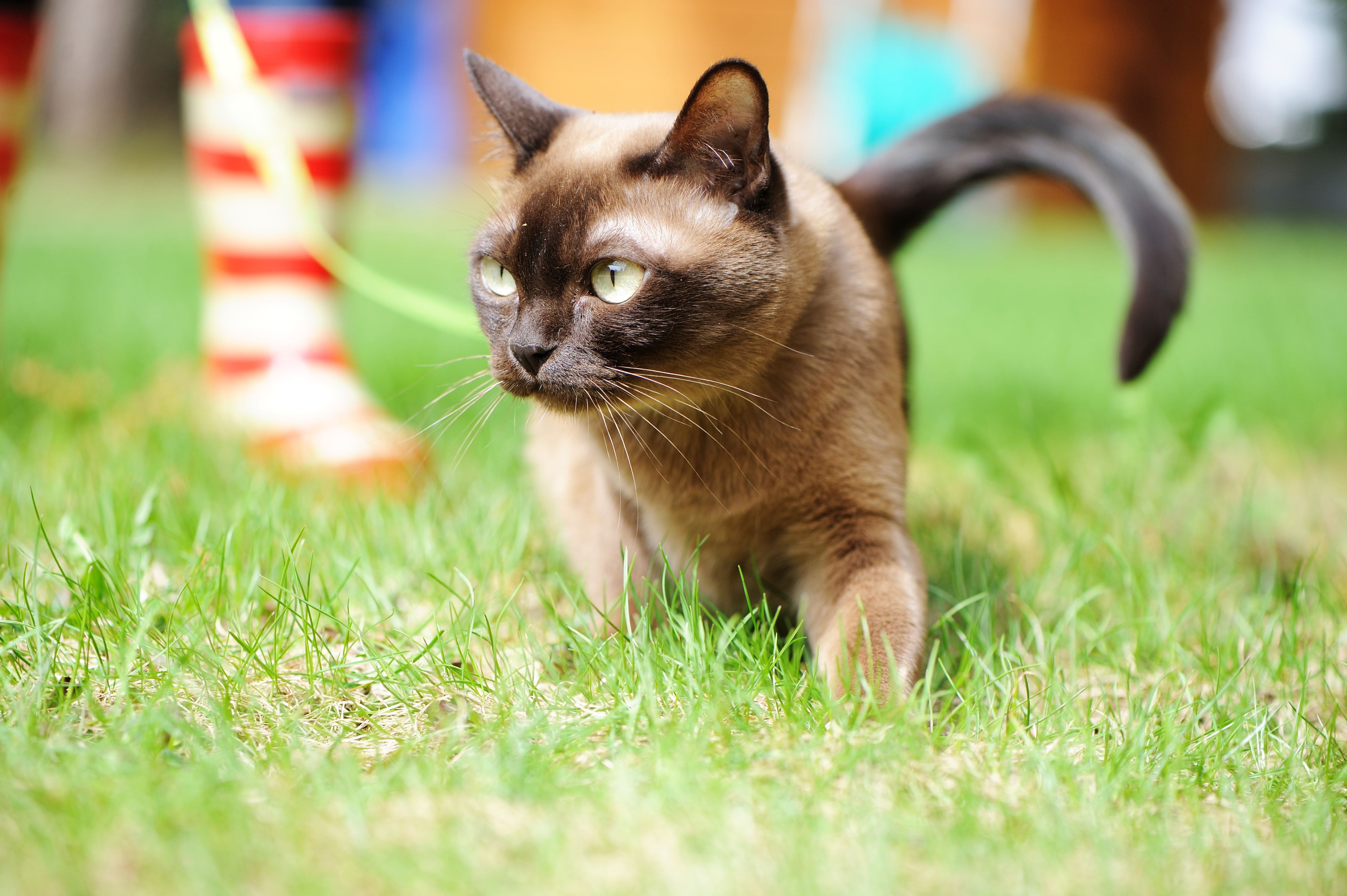 A Burmese cat walking outdoors on a leash and harness, demonstrating the breed's active nature and short coat, which is low-shedding and hypoallergenic.
A Burmese cat walking outdoors on a leash and harness, demonstrating the breed's active nature and short coat, which is low-shedding and hypoallergenic.
Photo credit: Adobe Stock/Alinute
Burmese cats are compact, muscular cats with short, satin-like coats. Their fine, short coat sheds minimally and requires little grooming, making them a good choice for allergy sufferers. Burmese cats are known for their affectionate, playful, and intelligent personalities. They are active cats that enjoy playing and interacting with their families, and they tend to be very people-oriented.
12. Tonkinese
 A champagne-colored Tonkinese cat sitting on the floor, looking directly at the camera, highlighting its short coat and suitability for people with cat allergies.
A champagne-colored Tonkinese cat sitting on the floor, looking directly at the camera, highlighting its short coat and suitability for people with cat allergies.
Photo credit: Adobe Stock/Steve Mann
Tonkinese cats are a blend of Siamese and Burmese traits, known for their beautiful aqua eyes and short, silky coats. Like their parent breeds, Tonkinese cats shed minimally and are considered relatively hypoallergenic. They are intelligent, social, energetic, and playful cats, known for their affectionate and engaging personalities. Tonkinese cats thrive on interaction and can be quite vocal, making them interactive and entertaining companions.
Tips for Minimizing Allergies When Adopting a Cat
Choosing a “hypoallergenic” breed is a great first step, but managing cat allergies effectively involves a multi-pronged approach. Here are some essential tips to help minimize your allergic reactions and enjoy life with your feline companion:
Thorough Research and Breed Interaction
Before bringing any cat home, especially if you have allergies, do your research on breeds known to be better for allergy sufferers. More importantly, spend time with the specific breed or individual cat you are considering adopting. Allergy reactions can vary even within a breed, and personal interaction is the best way to gauge your sensitivity. Visit the breeder or shelter and interact with the cat in a contained environment to see how your allergies respond.
Consult an Allergy Specialist
If you know you have cat allergies, consult with an allergist before adopting a cat. They can perform allergy testing to confirm your sensitivity and assess the severity of your allergies. Your allergist can also advise on allergy management strategies, including medications like antihistamines, nasal corticosteroids, or allergy shots (immunotherapy), which can significantly reduce your symptoms and improve your tolerance to cat allergens.
Create an Allergy-Conscious Home Environment
Making changes to your home environment can dramatically reduce allergen levels:
- Regular Cleaning is Key: Vacuum frequently (ideally daily) with a HEPA filter vacuum cleaner to trap allergens. Steam clean carpets and upholstery regularly.
- Hard Flooring Advantage: If possible, opt for hard flooring like wood or tile instead of carpets, which trap more allergens.
- Air Purifiers with HEPA Filters: Invest in high-quality air purifiers with HEPA filters for your main living areas and bedroom. These filters effectively remove airborne allergens, including cat dander.
- Frequent Washing: Wash bedding, curtains, and pet bedding frequently in hot water to remove allergens.
- Designated Cat-Free Zones: Consider making your bedroom a cat-free zone to ensure you have an allergen-free space to sleep.
- Reduce Clutter: Clutter collects dust and dander, so keeping your home tidy and minimizing unnecessary items can help reduce allergen buildup.
Grooming and Hygiene Practices
Regular grooming of your cat is vital for managing allergens:
- Regular Brushing: Brush your cat frequently (ideally daily or several times a week) to remove loose fur and dander. Do this outdoors or in a well-ventilated area, and consider wearing a mask.
- Bathing Your Cat (Occasionally): While cats are self-grooming, occasional baths (every 2-4 weeks) can help reduce dander and allergens on their skin. Use a veterinarian-recommended cat shampoo.
- Paw Cleaning: Wipe your cat’s paws regularly, especially after they have been outdoors, to prevent tracking allergens into your home.
- Litter Box Hygiene: Scoop the litter box at least once daily, as cat urine also contains Fel d 1. Use low-dust, unscented litter and place the litter box in a well-ventilated area.
Consider Allergen-Reducing Cat Food
Innovative cat food options are now available that can help reduce cat allergens. Purina® Pro Plan® LIVECLEAR is formulated to neutralize Fel d 1 in cat saliva, significantly reducing the active allergen transferred when cats groom. Consult with your veterinarian to determine if this diet is a suitable option for your cat and allergy management plan.
Strategic Veterinary Consultations
Regular veterinary check-ups are essential for your cat’s health and can indirectly help with your allergies:
- Skin Health: Healthy skin produces less dander. Work with your vet to ensure your cat has a healthy coat and skin through proper diet, grooming advice, and addressing any skin conditions.
- Diet and Nutrition: A balanced, high-quality diet contributes to overall health, including skin and coat health, which can influence allergen production and shedding.
FAQs About Living with Cats and Allergies
Are there any cats that don’t shed at all?
While no cat is completely non-shedding, some breeds like the Sphynx are virtually hairless and therefore don’t shed fur in the traditional sense. However, all cats, including hairless breeds, produce allergens in their skin, saliva, and urine.
Can a cat ever be 100% hypoallergenic?
No, the concept of a 100% hypoallergenic cat is a myth. All cats produce Fel d 1 protein, the primary cat allergen. “Hypoallergenic” breeds simply produce less of this protein or have coat types that may help reduce allergen dispersal.
Living with cat allergies and a feline companion requires commitment and proactive management. By choosing a breed known to be better for allergy sufferers, implementing diligent home and grooming strategies, and working with your allergist and veterinarian, it’s absolutely possible to create a harmonious home where both you and your cat can thrive, even if you’re allergic to cats.
WRITTEN BY

